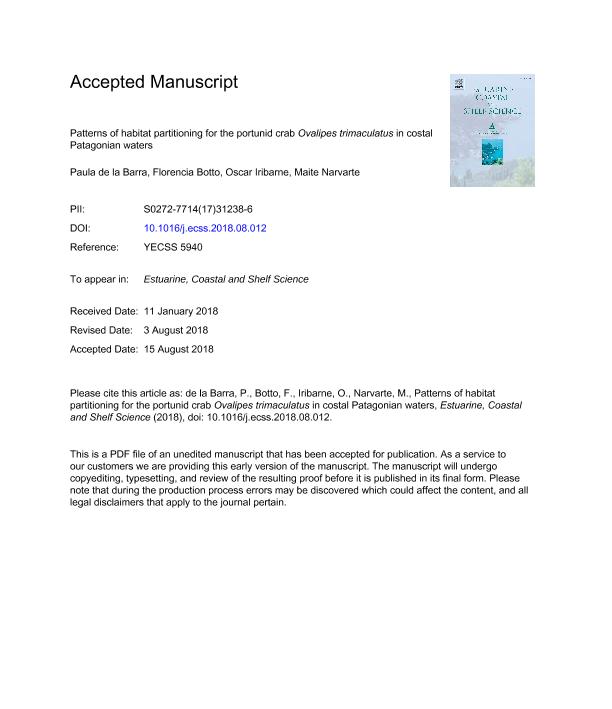Artículo
Patterns of habitat partitioning for the portunid crab Ovalipes trimaculatus in costal Patagonian waters
Fecha de publicación:
11/2018
Editorial:
Academic Press Ltd - Elsevier Science Ltd
Revista:
Estuarine, Coastal and Shelf Science
ISSN:
0272-7714
Idioma:
Inglés
Tipo de recurso:
Artículo publicado
Clasificación temática:
Resumen
Animals frequently face trade-offs between their requirements for maximizing growth and minimizing mortality risk. The partition of habitat use in foraging arenas and refuges as an answer to this trade-off has been evaluated in intertidal crabs but is poorly known in subtidal crabs. The subtidal crab Ovalipes trimaculatus lives and is captured by artisanal fishermen on sandy bottoms of the San Matías Gulf (Lat 41 °S; Argentina). Whereas these bottoms are poor in potential prey, the nearby rocky outcrops are much richer with relatively high abundance of potential prey for the species. Hence, we investigated if crabs in this area are using rocky bottoms as a foraging arena. Stomach content and stable isotopes analysis show that none of the evaluated prey (small teleosts, echinoderms, mollusks and crustaceans) contributed to more than 10% of O. trimaculatus diet, however prey from hard bottoms jointly contributed to 50–80% of the diet. Thus, O. trimaculatus is a generalist carnivore that, despite inhabiting mainly open sandy bottoms, uses rocky outcrops habitats as a foraging arena, probably due to their higher prey availability.
Archivos asociados
Licencia
Identificadores
Colecciones
Articulos(IIMYC)
Articulos de INSTITUTO DE INVESTIGACIONES MARINAS Y COSTERAS
Articulos de INSTITUTO DE INVESTIGACIONES MARINAS Y COSTERAS
Articulos(SEDE CENTRAL)
Articulos de SEDE CENTRAL
Articulos de SEDE CENTRAL
Citación
de la Barra, Paula María; Botto, Florencia; Iribarne, Oscar Osvaldo; Narvarte, Maite Andrea; Patterns of habitat partitioning for the portunid crab Ovalipes trimaculatus in costal Patagonian waters; Academic Press Ltd - Elsevier Science Ltd; Estuarine, Coastal and Shelf Science; 213; 11-2018; 92-97
Compartir
Altmétricas




